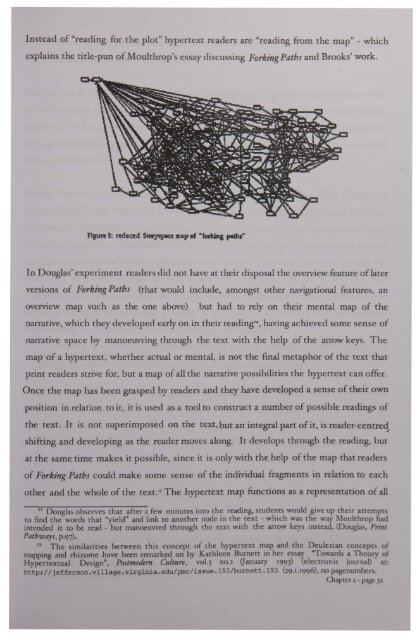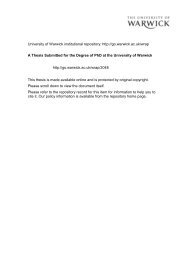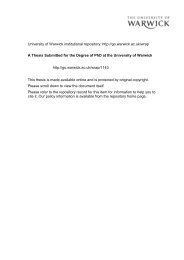From Page to Screen - WRAP: Warwick Research Archive Portal ...
From Page to Screen - WRAP: Warwick Research Archive Portal ...
From Page to Screen - WRAP: Warwick Research Archive Portal ...
You also want an ePaper? Increase the reach of your titles
YUMPU automatically turns print PDFs into web optimized ePapers that Google loves.
Instead of "reading for the plot" hypertext readers are "reading from the map" - which<br />
explains the title-pun ofMoulthrop's essay discussing Forking Paths and Brooks' work.<br />
In Douglas' experiment readers did not have at their disposal the overview feature oflater<br />
versions of ForkingPaths (that would include, amongst other navigational features, an<br />
overview map such as the one above) but had <strong>to</strong> rely on their mental map of the<br />
narrative, which they developed early on in their reading", having achieved some sense of<br />
narrative space by manoeuvring through the text with the help of the arrow keys. The<br />
map of a hypertext, whether actual or mental, is not the final metaphor of the text that<br />
print readers strive for, but a map ofall the narrative possibilities the hypertext can offer.<br />
Once the map has been grasped by readers and they have developed a sense oftheir own<br />
position in relation <strong>to</strong> it, it is used as a <strong>to</strong>ol <strong>to</strong> construct a number of possible readings of<br />
the text. It is not superimposed on the text, but an integral part ofit, is reader-centre'!<br />
shifting and developing as the reader moves along. It develops through the reading, but<br />
at the same time makes it possible, since it is only with the help of the map that readers<br />
of Forking Paths could make some sense of the individual fragments in relation <strong>to</strong> each<br />
other and the whole of the text." The hypertext map functions as a representation of all<br />
24 Douglas observes that after a few minutes in<strong>to</strong> the reading, students would give up their attempts<br />
<strong>to</strong> find the words that "yield" and link <strong>to</strong> another node in the text - which was the way Moulthrop had<br />
intended it <strong>to</strong> be read - but manoeuvred through the text with the arrow keys instead. (Douglas, Print<br />
Pathways, P.97).<br />
25 The similarities between this concept of the hypertext map and the Deulezian concepts of<br />
mapping and rhizome have been remarked on by Kathleen Burnett in her essay "Towards a Theory of<br />
Hypert tual Design", Postmodern Culture, vol.j nO.2 (January 1993) (electronic journal) at:<br />
http://jefferson.village.virginia.edu/pmc/issue. 193/burnett. 193 (29·1.1996), no pagenumbers.<br />
Chapter 2 - page 3 2





